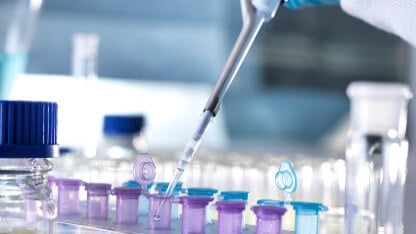Inorganic analysis services expertise for determining levels of metals, cations or anions in solid or liquid samples. Our qualitative inorganic analysis and quantitative inorganic analysis help to ensure quality, safety and mitigate risks of contamination of products and processes.
Inorganic analysis involves various analytical methods that can qualitatively or quantitatively determine the inorganic and elemental composition of solids or liquids or aqueous solutions, chemical mixtures, materials, or products. Inorganic chemical analysis can help determine components such as cations, metals, anions, or inorganic salts.
Identifying unknown components in your samples requires inorganic qualitative analysis or screening approaches applied by expert scientists who can select the most suitable routes to sample preparation and develop - and validate - the most appropriate quantitative methods. Quantitative inorganic analysis for accurately determining trace levels of inorganic components requires precise and accurate analytical instrumentation with interference removal capacity.
Our inorganic analysis scientists provide method development, screening and testing to help identify and measure inorganic elements within solid and liquid samples. Our specialist inorganic elemental analysis experience and knowledge within sample preparation means that we can apply our expertise to an extensive range of sample types from a wide range of industries, including food ingredients, cosmetics, pharmaceuticals, medical devices, chemical formulations, polymers, adhesives, agrichemicals, biocides and consumer products such as electronics, toys and packaging.
Inorganic Chemical Analysis Techniques
By applying our highly sensitive and highly selective modern instrumentation, we provide a trace-level analytical measurement of inorganic elements or trace metals that can range from parts per million (ppm), parts per billion (ppb) and parts per trillion (ppt) levels.
We use inductively coupled plasma – optical emission spectroscopy (ICP-OES) and inductively coupled plasma – mass spectrometry (ICP-MS) which detects trace levels of elements through to percentage levels across a range of matrices and is routinely used for in trace metals analysis. Ion chromatography is used to determine anions and cations in liquid samples. We also have High-Performance Wavelength Dispersive XRF spectrometry (XRF) and XRF2 mapping, which provides rapid non-destructive trace elemental analysis of solid and powder samples with the ability to map individual elements for solid samples and surfaces. Scanning Electron Microscopy with Energy Dispersive X-ray Spectroscopy and combustion techniques (elemental analysers capable of analysing for carbon, hydrogen, nitrogen, sulphur, oxygen and chlorine) can help build understanding of elemental distribution and concentration.
We have over 30 years of experience in inorganic chemical analysis. We routinely provide inorganic analysis services to resolve contamination issues, determine levels of metals, including heavy metals, in products, support research and development, quality control for production and failure investigations. We provide inorganic analysis services across the pharmaceutical, materials, medical, cosmetics, petroleum, and speciality chemicals sectors.
With a team of experts in inorganic analysis working to industry or regional standards - for example, ISO 17025 or GXP Standards, Intertek can provide the analytical data you require to progress your product development programs or solve problems across a wide range of sample types.
Inorganic elemental analysis resources
- XRF X-Ray Fluorescence Analysis
- X-Ray Diffraction
- Inductively Coupled Plasma Spectroscopy (ICP) Analysis
- ICP-OES Inductively Coupled Plasma Spectroscopy - Optical Emission Spectroscopy
- ICP-MS Inductively Coupled Plasma Spectroscopy - Mass Spectrometry
- Combustion Analysers for common elements (Carbon, Hydrogen, Nitrogen, Oxygen, Sulphur, (CHNOS))
- Microcoulometry
- Working concentration ranges from percent to parts per trillion (ppt)
Inorganic trace analysis
- Elemental Trace Analysis
- Trace Metals Analysis
- Trace Metals in Petroleum
- Chemical Trace Analysis
- Contamination Detection and Analysis
- Food contact migration studies e.g. inorganics into food simulants
- Catalyst characterisation and catalyst poisoning problems
- Identifying unique markers, trace elements within a product to defend against copying and legal claims
- Identification of unknowns, competitive materials, unwanted material from production
- Safety assessment, occupational hygiene in the workplace
- Investigation of colour defects in a product, checking for correct polymer additives
Inorganic analysis advantages:
- Techniques are complementary to other methods such as powder X-Ray Diffraction (pXRD) , X-ray photoelectron spectroscopy (XPS) and Microscopy
- High sensitivity, high selectivity instrumentation
- Not limited by sample type
- Specialist experience and knowledge for crucial sample preparation
- Work to industry and government regulatory standards, as required
- Fast response and flexibility

